文体学与基础英语教学
- 格式:pdf
- 大小:180.58 KB
- 文档页数:2
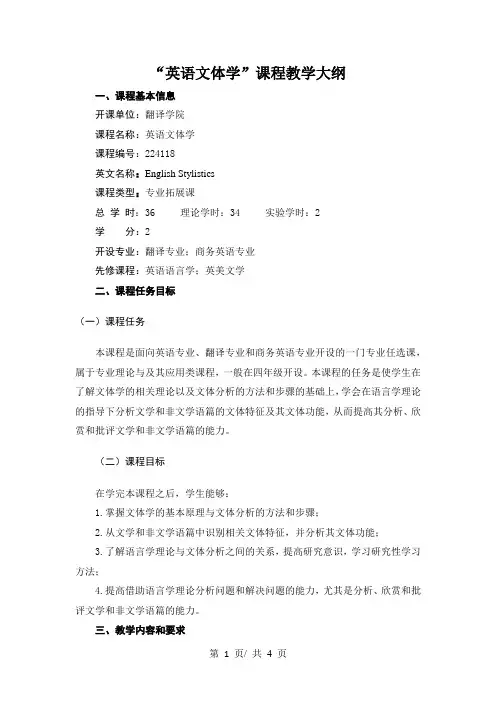
“英语文体学”课程教学大纲一、课程基本信息开课单位:翻译学院课程名称:英语文体学课程编号:224118英文名称:English Stylistics课程类型:专业拓展课总学时:36 理论学时:34 实验学时:2学分:2开设专业:翻译专业;商务英语专业先修课程:英语语言学;英美文学二、课程任务目标(一)课程任务本课程是面向英语专业、翻译专业和商务英语专业开设的一门专业任选课,属于专业理论与及其应用类课程,一般在四年级开设。
本课程的任务是使学生在了解文体学的相关理论以及文体分析的方法和步骤的基础上,学会在语言学理论的指导下分析文学和非文学语篇的文体特征及其文体功能,从而提高其分析、欣赏和批评文学和非文学语篇的能力。
(二)课程目标在学完本课程之后,学生能够:1.掌握文体学的基本原理与文体分析的方法和步骤;2.从文学和非文学语篇中识别相关文体特征,并分析其文体功能;3.了解语言学理论与文体分析之间的关系,提高研究意识,学习研究性学习方法;4.提高借助语言学理论分析问题和解决问题的能力,尤其是分析、欣赏和批评文学和非文学语篇的能力。
三、教学内容和要求Chapter 1 Introduction本章是整个课程的导入部分,目的是让学生了解文体学的定义及其产生背景和过程、理论假设以及文体学研究的目标和文体分析的基本步骤,并了解文体学的基本特征。
具体内容如下:Defining stylistics;Naissance of stylistics as an interdisciplinary field of study;Two important assumptions of stylistics;Goals, components and procedure of stylistic inquiry;Nature of stylistic analysis。
Chapter 2 On style本章在介绍文体学界的三种典型文体观的基础上,列举文体的分类特征,讨论多种英语变体的基本特征,并分析文体的正式程度及其语言表现形式。
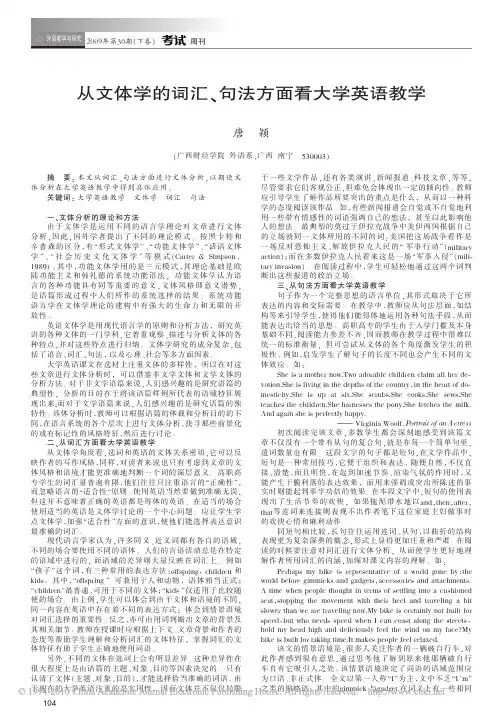
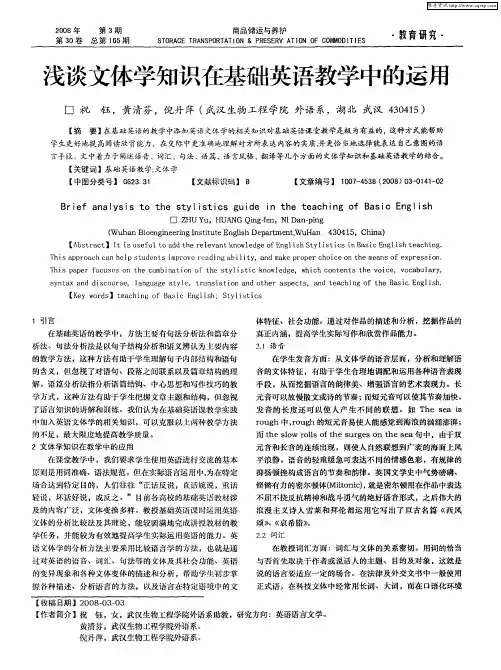
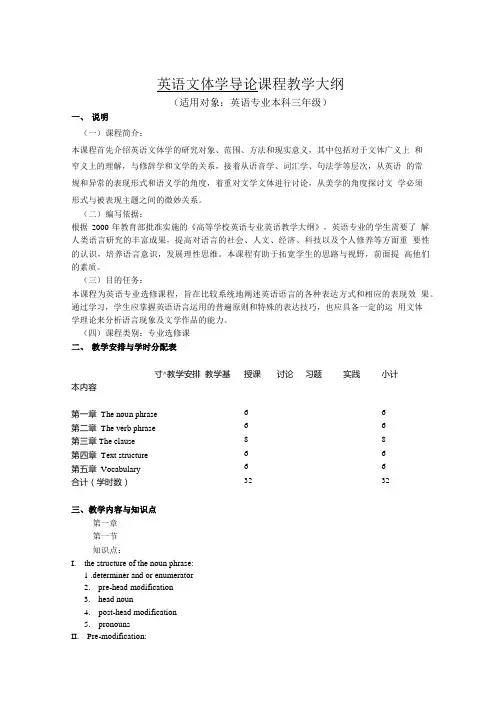
英语文体学导论课程教学大纲(适用对象:英语专业本科三年级)一、说明(一)课程简介:本课程首先介绍英语文体学的研究对象、范围、方法和现实意义,其中包括对于文体广义上和窄义上的理解,与修辞学和文学的关系,接着从语音学、词汇学、句法学等层次,从英语的常规和异常的表现形式和语义学的角度,着重对文学文体进行讨论,从美学的角度探讨文学必须形式与被表现主题之间的微妙关系。
(二)编写依据:根据2000年教育部批准实施的《高等学校英语专业英语教学大纲》,英语专业的学生需要了解人类语言研究的丰富成果,提高对语言的社会、人文、经济、科技以及个人修养等方面重要性的认识,培养语言意识,发展理性思维。
本课程有助于拓宽学生的思路与视野,前面提高他们的素质。
(三)目的任务:本课程为英语专业选修课程,旨在比较系统地阐述英语语言的各种表达方式和相应的表现效果。
通过学习,学生应掌握英语语言运用的普遍原则和特殊的表达技巧,也应具备一定的运用文体学理论来分析语言现象及文学作品的能力。
(四)课程类别:专业选修课二、教学安排与学时分配表授课讨论习题实践小计寸^教学安排教学基本内容第一章The noun phrase 6 6第二章The verb phrase 6 6第三章The clause 8 8第四章Text structure 6 6第五章Vocabulary 6 6合计(学时数)3232三、教学内容与知识点第一章第一节知识点:I.the structure of the noun phrase:1 .determiner and or enumerator2.pre-head modification3.head noun4.post-head modification5.pronounsII.Pre-modification:III.Post-modification:第二节知识点:I.Articles:II.Pronouns: denoting the first-person singularIII.Pronouns: denoting the first-person plural第三节知识点:I.Pronouns: the second person (1):II.Practical work on the use of you'.III.Pronouns: the second person (2):第二章第一节知识点:I.Introduction: the structure of the verb phrase:1.main verb2.auxiliary3.negative particles4.tense5.finite verb phrases6.non-finite verb phrasesII.Narrative time, story time and tense:III.Simple and compound verb phrases:第二节知识点:es of the present tense:II.The passive:III.The imperative:第三节知识点I.Non-finite verb forms: 6to+ base' form (the infinitive) II.Non-finite verb forms: i-ing, forms:III.Non-finite verb forms: time and tense:第三章AA- -£+■ 第一Ti知识点:I.Introduction to syntax:1 .information: given and new2.simple sentence3.coordination4.subordinationII.Analyzing clause structure:第二节知识点:I.The relationship between S and V:II.Relative size of syntactic elements: light X elements: III.Obligatory X elements (transitivity)第三节知识点I.Expansion of X elements:II.Heavy S and X elements before the verb:III.Placement of adverbials in the clause:第四节知识点:I.Main clausesII.Coordination:III.Subordination and the sentence:第五节知识点:I.Ambiguity in syntax:II.Prepositions:III.Interrogatives:第四章第一节知识点I.Introduction to text structure: cohesion and coherence rmation structure: given to newIII.Ellipsis:第二节知识点:I.Coherent models: thoughtII.Coherent models: other languagesIII.Coherent models: speech第五章第一Ti知识点:I.Introduction to vocabulary:1 .Contributing factors to the formation of current English2.Sources of current EnglishII.Register: use of romance vocabularyIII.Register: use of 'long' words企―> -++■第一Ti知识点:I.Word-formation: bound morphemesII.Romance:III.Semantic fields:第二Ti知识点I.Collocation:II.Synonyms:1.the distinction of synonyms on the basis of their reference2.the distinction of synonyms on the basis of their register:四、考核方法与要求(一)考核形式:课堂提问和讨论、期末论文(二)成绩计算方法:课堂考核占30%;课程论文占70%五、教材与参考教材(一)Laura Wright & Jonathan Hope: Stylistics: A Practical Course Book (二)G. N. Leech: Style in Fiction(三)Carter & Simpson: Language, Discourse and Literature:An Introductory Reader in Discourse Stylistics。
![[生活]为什么英语文体学的学习有助于英语学习](https://uimg.taocdn.com/89da96150640be1e650e52ea551810a6f524c8a2.webp)
为什么英语文体学的学习有助于英语文体学研究语言使用的规律,即语音、词汇和语法在具体语境中是如何运用的。
这无疑对于外语教学具有特别重要的意义。
中国外语界最早注意到这一点并积极倡导开设文体学课的当数王佐良先生。
关于英语文体学的文体、风格研究对英语学习所起到的作用,他曾提出三个方面的好处。
第一,在全部文体、风格的研究中,最经常也是最重要的活动是比较和选择,比较各种近似的表达手段,观察它们之间的细微差别,根据要表达的思想感情来决定何者最为适合,最为有效,在这样的过程里我们不仅会变得更加精细、准确,而且会更加注意形式与内容的统一。
第二,既然从使用和实效出发,文体、风格的研究要求我们注意英语的现状,远过于英语的过去,这样我们就会更加熟悉现代英语里各种通常的表达手段。
第三,文体、风格成分复杂,包含了语音、词汇、语法以至心理、政治、社会等各方面的因素,一个研究者必须对它们作综合的考虑,而且还要从局部(一词一句)进到全体(一段一篇),又从全体回到局部,检验并深化对局部的了解,因此既要具体,又要全面,既要掌握语言事实,要体会感情色彩和全盘的情调气氛。
王先生的观点对于大学英语教学是非常有借鉴意义的。
下面谈谈把文体学知识融入大学英语教学的积极作用。
首先,将英语文体学的文体、风格研融入大学英语教学可以使学生更精细、更准确地掌握英语语言特征。
在传统大学英语教学中,只要求学生掌握现成的语言现象和语言知识,以教师传授,学生记忆为主,学生很少参与到思考和分析语言现象的过程中。
大学英语教学实践告诉我们:如果不对语言进行深层次的思考和分析,将无法获得语言的精髓。
而文体学要求运用比较、选择等各种方法对英语篇章的文体和风格进行细致入微的研究和分析,这对于培养学生的综合英语语言素质有极大的好处,也符合语言学习的客观规律。
其次,将英语文体学的文体、风格研究融入大学英语教学可以使教师和学生关注英语语言的实际使用情况。
目前在大学英语教学中有这样的现象:许多学生,甚至包括一些教师,将英语语言现象局限在所学或所教的课文中,以为这就是英语”。

浅议英语文体学理论与大学英语教学的结合摘要:英语文体学理论对改进大学英语教学起到很大的作用,它能帮助学生提高阅读欣赏能力,在交际中更准确地理解对方所表达内容的实质,并恰当地选择能表达自己意图的语言手段与方式。
本文在语音、词汇、句法、语篇、等几个方面较详细地阐述了英语文体学理论与大学英语教学的结合所带来的影响及其具体的结合方式。
在大学英语教学中将英语文体学理论进行紧密结合将会带来极好的实际效果。
关键词:英语文体学;大英教学;作用;结合一、认识英语文体学及其对大学教学的作用“文体”(style)指某种语体的风格特征,即适于某特定语言环境的一整套语言变异形式。
文体学首先来自于古代的修辞学,来自于亚里斯多德的修辞论。
现代文体学创始人是法国文体学家巴利(索绪尔的学生),文体学的性质是一门结合文学和语言学的交叉学科,适宜于对文学和语言学很感兴趣的学生学习的一门课程。
简单地说,文体学就是运用语言学的理论去阐释文学内容和写作风格的一门学科。
帮助学生理解作品的深刻内涵和写作技巧。
同时,激发学生开展批评性阅读,尝试建立自己的见解。
文体学研究语言使用的规律,体现在语言运用的各个层面,如语音、书写、词汇、句法结构乃至篇章类型的选择上。
文体分析就是在语音、书写、词汇、语法、篇章结构等各个层面进行的,其重点是分析具有文体意义(stylistic significance)和美学价值的那些语言特征,从那些被“前景化”了的语言特征(fore-grounded features)入手,挖掘作者的语用意图和语用效果,以便达到鉴赏的目的。
大学的英语课主要指精读课,该课程在起始阶段的主要目的是帮助学生掌握语言形式(即语音、语法和基本词汇)并熟悉语言的基本技能(听、说、读、写)。
至于内容的掌握,一般要求学生在懂得语言形式的基础上,懂得作者或讲话人在表述事实过程中,对所表述之事实所持的“态度”。
然而,进入大学阶段,社会对学生的要求已不仅仅是语言技能,更主要体现在文本解读和鉴赏上,长期以来我们多采用传统的分析,如文章结构划分,段落大意,中心思想等,这样以来学生缺乏多角度的观察和思考,所以将文体学知识引入到大学英语课堂教学中,无疑是非常好的一种方法。
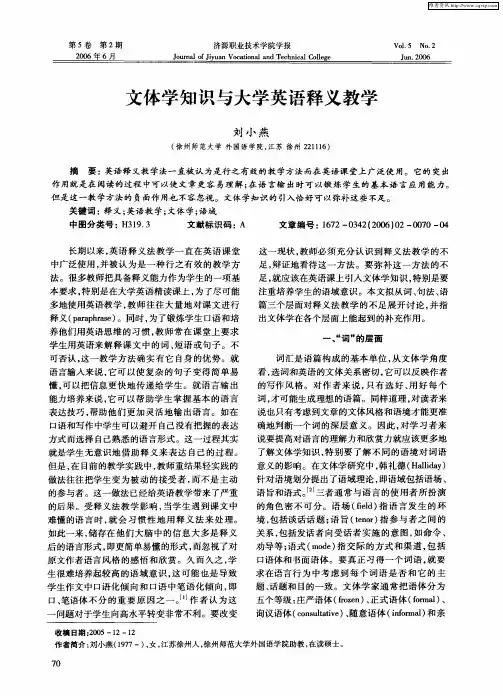
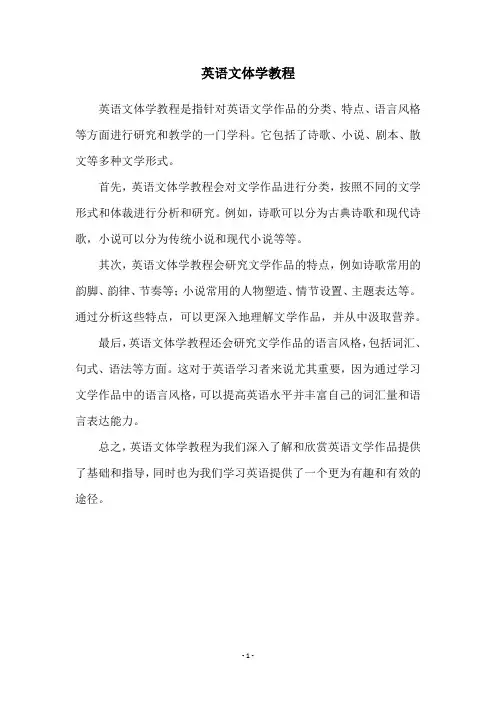
英语文体学教程
英语文体学教程是指针对英语文学作品的分类、特点、语言风格等方面进行研究和教学的一门学科。
它包括了诗歌、小说、剧本、散文等多种文学形式。
首先,英语文体学教程会对文学作品进行分类,按照不同的文学形式和体裁进行分析和研究。
例如,诗歌可以分为古典诗歌和现代诗歌,小说可以分为传统小说和现代小说等等。
其次,英语文体学教程会研究文学作品的特点,例如诗歌常用的韵脚、韵律、节奏等;小说常用的人物塑造、情节设置、主题表达等。
通过分析这些特点,可以更深入地理解文学作品,并从中汲取营养。
最后,英语文体学教程还会研究文学作品的语言风格,包括词汇、句式、语法等方面。
这对于英语学习者来说尤其重要,因为通过学习文学作品中的语言风格,可以提高英语水平并丰富自己的词汇量和语言表达能力。
总之,英语文体学教程为我们深入了解和欣赏英语文学作品提供了基础和指导,同时也为我们学习英语提供了一个更为有趣和有效的途径。
- 1 -。
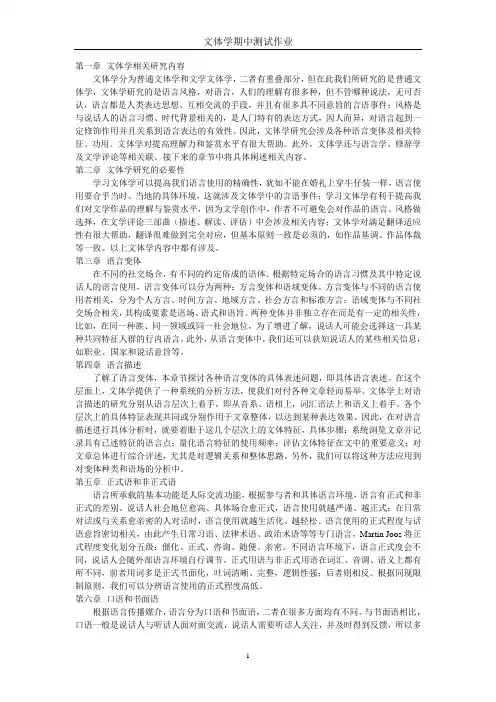
第一章文体学相关研究内容文体学分为普通文体学和文学文体学,二者有重叠部分,但在此我们所研究的是普通文体学,文体学研究的是语言风格,对语言,人们的理解有很多种,但不管哪种说法,无可否认,语言都是人类表达思想、互相交流的手段,并且有很多具不同意旨的言语事件;风格是与说话人的语言习惯、时代背景相关的,是人门特有的表达方式,因人而异,对语言起到一定修饰作用并且关系到语言表达的有效性。
因此,文体学研究会涉及各种语言变体及相关特征、功用。
文体学对提高理解力和鉴赏水平有很大帮助。
此外,文体学还与语言学、修辞学及文学评论等相关联。
接下来的章节中将具体阐述相关内容。
第二章文体学研究的必要性学习文体学可以提高我们语言使用的精确性,犹如不能在婚礼上穿牛仔装一样,语言使用要合乎当时、当地的具体环境,这就涉及文体学中的言语事件;学习文体学有利于提高我们对文学作品的理解与鉴赏水平,因为文学创作中,作者不可避免会对作品的语言、风格做选择,在文学评论三部曲(描述、解读、评估)中会涉及相关内容;文体学对满足翻译适应性有很大帮助,翻译很难做到完全对应,但基本原则一致是必须的,如作品基调、作品体裁等一致。
以上文体学内容中都有涉及。
第三章语言变体在不同的社交场合,有不同的约定俗成的语体。
根据特定场合的语言习惯及其中特定说话人的语言使用,语言变体可以分为两种:方言变体和语域变体。
方言变体与不同的语言使用者相关,分为个人方言、时间方言、地域方言、社会方言和标准方言;语域变体与不同社交场合相关,其构成要素是语场、语式和语旨。
两种变体并非独立存在而是有一定的相关性,比如,在同一种族、同一领域或同一社会地位,为了增进了解,说话人可能会选择这一具某种共同特征人群的行内语言。
此外,从语言变体中,我们还可以获知说话人的某些相关信息,如职业、国家和说话意旨等。
第四章语言描述了解了语言变体,本章节探讨各种语言变体的具体表述问题,即具体语言表述。
在这个层面上,文体学提供了一种系统的分析方法,使我们对付各种文章轻而易举。
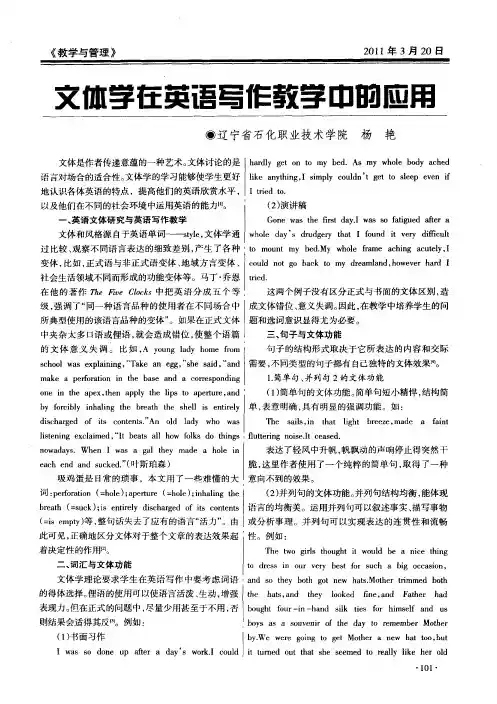
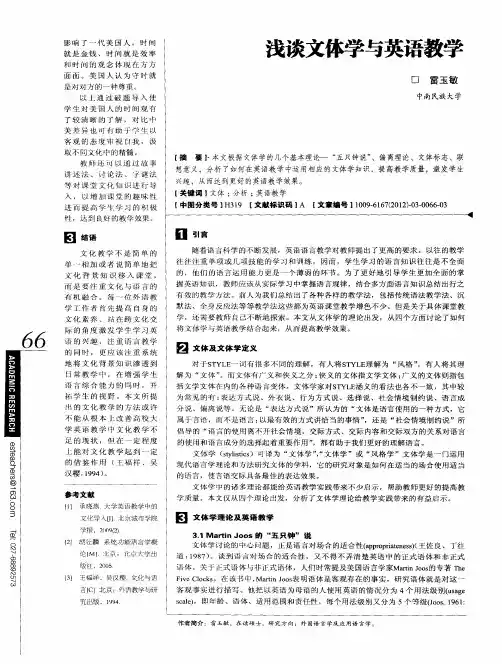
《英语文体学》教学大纲一、基本信息二、教学目标及任务本课程要求学生识记文体、文体学的定义,文体学的流派,文体学在国内外的发展情况,了解并学会使用分析不同文体篇章的方法和步骤,帮助学生学会观察和描述若干主要文体的语言风格,即它们各自的语音、词汇、句法与篇章的特点,以便更好地了解它们所表达的内容和在恰当场合使用它们。
三、学时分配四、教学内容及教学要求第一章绪论:文体及文体学定义习题要点:文体学的定义本单元重点、难点:文体学的广义及狭义定义本单元教学要求:使学生了解文体有广狭两义。
狭义的文体指文学文体,包括个别作家的风格;广义的文体指一种语言中的各类文体,例如口语体、书面体,而这两者之中,又有若干文体。
理解文体学的任务不在于若干文体的名目,而在观察和描述若干主要文体的语言风格,即它们各自的语音、词汇、句法与篇章的特点,其目的在于使学习者更好地了解它们所表达的内容和在恰当场合使用它们。
第二章文体学的历史沿革和流派习题要点:文体学的分类、文体学的流派、文体学在国内外的发展情况本单元重点、难点:文体学的沿革本单元教学要求:使学生了解文体学的沿革,文体学研究的主要流派。
理解文体学可分为普通文体学、文学文体学、理论文体学等。
第三章文体分析的方法和步骤习题要点:文体分析的方法和步骤本单元重点、难点:对文体进行分析的三个步骤本单元教学要求:讲授、并使学生了解文体分析的三个步骤:(1)linguistic description(2)textual analysis(3)contextual factors analysis第四章英语公共演讲的文体特征习题要点:英语公共演讲的文体功能分析本单元重点、难点:词汇的文体功能本单元教学要求:熟悉与词汇手段相关的文体标志。
通过对公共演讲的实例分析,理解文体与选词的关系,各类词语的文体特征,词的意义,词的涵义,建立在词汇层面上的修辞手法等。
第五章英语新闻的文体特征习题要点:英语新闻报道的文体功能分析本单元重点、难点:句式的选择与表达效果之间的关系本单元教学要求:熟悉与句法手段相关的文体标志。
第一章1.1 Definition of StylisticsStylistics has long been considered as a highly significant but very discussible branch of learning. It is concerned with various disciplines such as linguistics, semantics, pragmatics and literature. The word stylistics( ‘styl’ component relates stylistic to literary criticism, and the ‘istics’ component to linguistics). So stylistics is the bridge of linguistics and literature. Stylistics is the study of literary discourse from a linguistic orientation.” (文体学是从语言学的角度研究文学语篇)Stylistics is an interdisciplined branch of learning which studies various differences between formal and informal, between deviant and normal, between magnificent and plain, between professional and popular, between foreign and domestic, between this and that individual.1.2 The Development of StylisticsThe date when stylistics became a field of academic inquiry is difficult to determine. However stylistics is often considered as both an old and a young branch of learning. It is old, because it orig inated from the ancient “rhetoric”. The famous ancient Greek philosophers Socrates, Plato and Aristotle all contributed a lot to this branch of learning. It is young ,because the word “stylistics” first appeared only in 1882, and the first book on stylistics was written by a French scholar Charles Bally in 1902 and was published in 1909: Traite de Stylistique Francaise. This book is often considered as a landmark of modern stylistics. Consequently, a number of more coherent and systematic works of both a theoretical and a practical nature were published in the field.The subject of study in Bally’s time was oral discourse. Bally considered that apart from the denotative meaning expressed by the speaker4, there was usually an “overtone” which indicated differ ent “feelings”, and the task of stylistics was to find out the linguistic devices indicating these feelings.Later , the German scholar L.Spitzer(1887-1960), began to analyze literary works from a stylistic point of view, and therefore, Spitzer if often co nsider4ed as the “father of literary stylistics”.From the beginning of the 1930s to the end of the 1950s stylistics was developing slowly and was only confined to the European continent. From the end of the 1950s to the present time, modern stylistics has reached its prosperity.1.3 Definitions of StyleSo style is an integral part of meaning. It gives us additional information about the speaker’s/writer’s regional and social origin, education, his relationship with the his/her reader, his feelings, emotions or attitudes. Without a sense of style we cannot arrive at a better understanding of an utterance1).Written---spoken in terms of channel2)The Differences between Formal and Informal Language3)modern----archaic in terms of time4)normal----deviated in terms of degree of novelty5). common---professional in terms of technique(专业)Homework:1.What’s stylistics?2.What does stylistics study?3.Say something about the development of stylistics.4.Give examples to explain “Proper words in proper places makes the true definition of a style.”5.What does style study?6.Give example to illustrate the differences between spoken-- written,formal–informal, modern–archaic, norm—deviated, common---professional.第二章1. Definition of meanings of meaningAccording to Leech (1974 English linguists), meanings of meaning can be broken into seven kinds:1).Denotative meaningIt refers to literal meaning, refers to diction meaning.(super meaning) 词的概念意义。
《英语文体学》课程教学大纲课程编号:ENGL3002课程类别:专业选修课授课对象:英语、英语师范专业开课学期:秋(第7学期)学分:2主讲教师:王军指定教材:《新编英语文体学教程》,董启明主编,外语教学与研究出版社,2008年。
教学目的:英语文体学是一门实用性非常强的学科,对阅读、翻译、文章分析、文章欣赏以及得体地使用英语都有很大的帮助,此外,英语文体学也是英语语言学研究重要的基础性学科之一。
作为一门课程,英语文体学主要由两部分构成:其一为文体学研究主要内容介绍,包括文体类型、文体特征、文体价值等方面,其次为具体文体分析方法介绍。
第一课Introduction to Stylistics课时:第一周,共2课时教学内容:What is stylistics and how is it associated with other linguistic studies?第一节:The position of stylistics in general linguistics.The importance of studying stylistics.第二节:What is stylistics?The major contents of this study.Issues that need to be born in mind.思考题:1.How to do stylistics in the framework of literature or translation?2.What do you expect to learn from this course?第二课Style and Stylistics课时:第二周,共2课时教学内容:The development and scope of stylistics第一节:The definition of style and stylistics.The relationship between appreciation and research.第二节:The development of stylistics.The scope of stylistics.思考题:1.What are the major differences between style and stylistics?2.What areas in society can the knowledge of stylistics be applied to?第三课Procedure of stylistic analysis (1)课时:第三周,共2课时教学内容:Linguistic description第一节:Linguistic description: methods and procedures.第一节:A checklist of linguistic description.The functions of each one.思考题:1.Why do we need linguistic description?2.Think about the significance of conducting linguistic description.第四课Procedure of stylistic analysis (2)课时:第四周,共2课时教学内容:Textual analysis and contextual factors analysis第一节:What is textual analysis?How to conduct textual analysis?第二节:A classification of contextual factors.How to analyze contextual factors?思考题:1.How do you understand the relationship between understanding and textual analysis?2.Are there other ways to classify contextual factors?第五课Stylistic functions of linguistic items课时:第五周,共2课时教学内容:Stylistic functions as defined at different levels第一节:Stylistic functions of speech sounds.Stylistic functions of graphological items.第二节:Stylistic functions of lexical items.Stylistic functions of syntactic/grammatical items.思考题:1.How do you evaluate the different kinds of stylistic functions?2.What is the significance of studying stylistic function?第六课Varieties in relation to regions课时:第六周,共2课时教学内容:Regional English第一节:A brief introduction to British English.The appearance of American English.第二节:Differences between British English and American English.British and American regional dialects.思考题:1.What are the major causes for the differences between British English and American English?2.How to deal with the use of the two regional English in actual learning or dailycommunication?第七课Varieties in relation to media课时:第七周,共2课时教学内容:Spoken English and written English第一节:Major features of spoken English and written English.What are the standards of using spoken English or written English?第二节:Electronic English.思考题:1.What is the situation like if one is only skilled in using spoken English or written English?2.What is the role of electronic English in the course of learning English?第八课Varieties in relation to attitude课时:第八周,共2课时教学内容:Attitude-related styles第一节:Degree of formality.Politeness.第二节:Impersonality.Accessibility.思考题:1.Think about the relationship between meaning and emotion expressions.2.What do you think of the relationship between formality and politeness?第九课Varieties in relation to social factors课时:第九周,共2课时教学内容:Social factors and their constraints on language第一节:Women’s English.Black English.第二节:Taboo and euphemism.Cultural factors involved in social factors.思考题:1.What are the reasons that maintain the existence of women’s English?2.How do you understand the status of black’s English and the black’s social status?第十课Review of the past lessons课时:第十周,共2课时教学内容:A summary and comment of the past lessons第一节:The watershed of the whole course.Recall what have been learned.第二节:What are the sections that interest you the most?Is there possibility for you to conduct further research?第十一课The English of conversation课时:第十一周,共2课时教学内容:Conversational English第一节:A general introduction to what to learn in the latter half of the term.About conversation.Phonological features.第二节:Lexical features.Syntactic/grammatical features.Semantic features.Sample analysis of a student.思考题:1.How do you understand conversation in terms of direct speech and indirect speech?2.Is conversational English always informal?第十二课The English of public speaking课时:第十二周,共2课时教学内容:Public speech and its features第一节:What is public speech?Public speeches’ phonological features.Lexical features.第二节:Syntactic/grammatical features.Semantic features.Sample analysis of a student.思考题:1.What are the major differences between public speaking and conversation?2.What are the major differences between public speech and written English?第十三课The English of news reporting (1)课时:第十三周,共2课时教学内容:General knowledge about news reporting第一节:What are news reports?Different kinds of newspapers and magazines.第二节:The make-up of news reports.A sample analysis of a piece of newspaper (New York Times/China Daily)思考题:1.Is there any difference between formal news report and informal news release?2.Specify the make-up of some pages of newspaper, both English and Chinese.第十四课The English of news reporting (2)课时:第十四周,共2课时教学内容:Stylistic features of news reporting第一节:Graphological features.Lexical features.第二节:Syntactic/grammatical features.Semantic features.Sample analysis of a student.思考题:1.What are the functions of each group of stylistic features in news reporting?2.What are the stylistic features that distinguish news reporting from other textual styles?第十五课The English of Advertising课时:第十五周,共2课时教学内容:The language styles in advertising English第一节:Something about advertisements.Graphological features.第二节:Lexical features.Syntactic/grammatical features.Semantic features.Sample analysis of a student.思考题:1.What are the major purposes of advertisements?2.Give some advertising examples that show the violation of some basic language rules inadvertising.第十六课Literary English课时:第十六周,共2课时教学内容:Literary English: novel and poetry第一节:Some basic facts about the novel.Aspects for the analysis of the novel.General stylistic features of the novel.第二节:Some basic facts about the poetry.Prosody.General stylistic features of poetry.思考题:1.Between fiction and reality, what kinds of stylistic features are most suitable for the novel?2.What effects does it have on appreciation to analyze the novel’s stylistic features?3.How to balance meaning expression and poetic features in poetry?4.What are the common stylistic features between poetry and novel?第十七课:The English of science and technology课时:第十七周,共2课时教学内容:Technical English第一节:Graphological features.Lexical features第二节:Syntactic/grammatical features.Semantic features.思考题:1.How to handle formality and politeness issues in technical English?2.How is objectivity achieved in technical English?第十八课:Review and answer questions课时:第十八周,共2课时教学内容:Review and answer questions第一节:Review.第二节:Answer questions.参考书目:1.王守元.《英语文体学要略》.济南:山东大学出版社,2000.2.徐有志.《英语文体学教程》.北京:高等教育出版社,2005.3.Thornborrow,J. Patterns in Language: Stylistics for Students of Language and Literature.Beijing: Foreign Language Teaching and Research Press, 2000.4.Wright, L. Stylistics: A Practical Coursebook. Beijing: Foreign Language Teaching andResearch Press, 2000.。